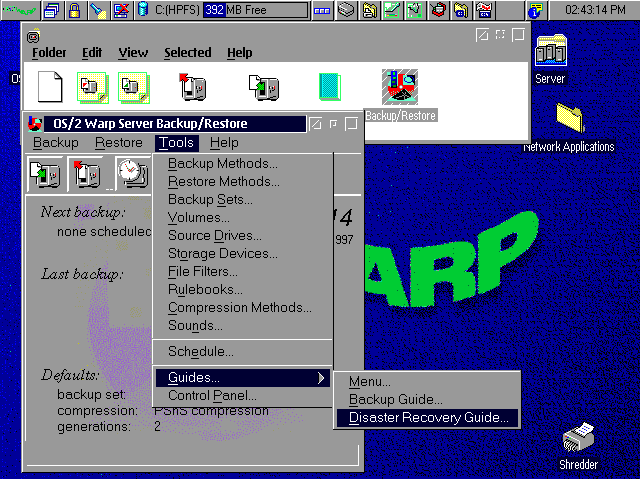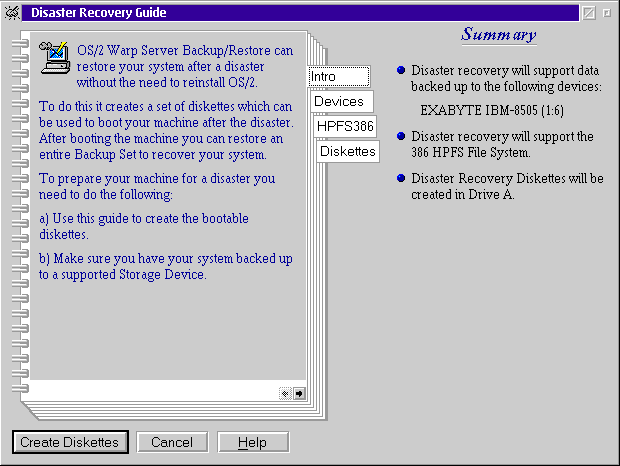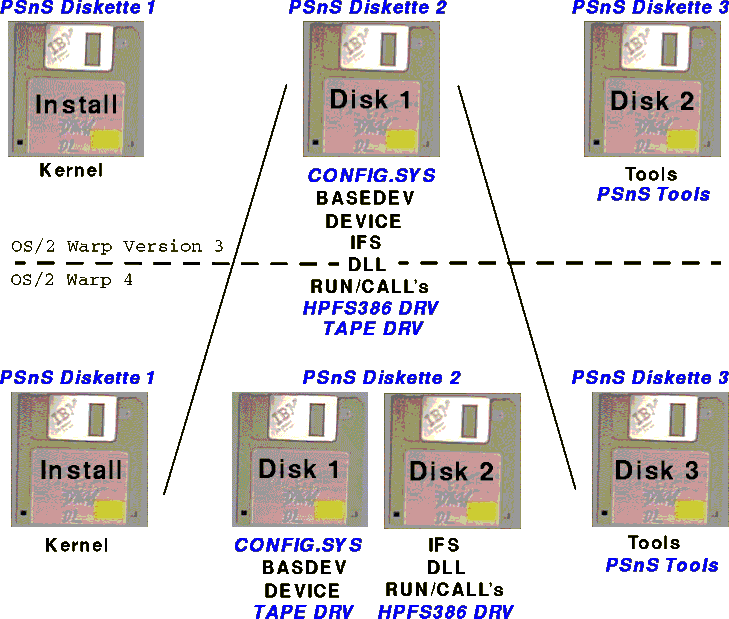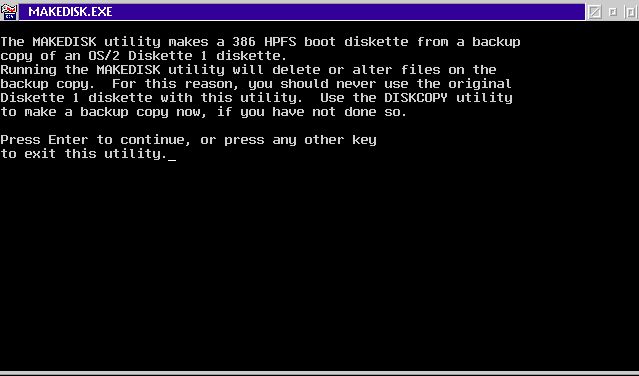


 10.1 Installing
PSnS
10.1 Installing
PSnSBoot diskettes are used to boot a system when the boot from hard disk fails or when all the files on the hard disk need to be accessible and not in use. For a plain OS/2 system these diskettes are called utility diskettes. They can be built if you use the Icon Create Utility Diskettes which is found under OS/2 System and then System Setup.
On a server that uses HPFS386, these diskettes need to be modified in order to be able to access the HPFS386 file system. There is a utility called MAKEDISK stored in the \IBMLAN\NETPROG directory that allows you to easily make these modifications.
If you build Disaster Recovery Diskettes under PSnS, a combination of both processes is used. This can lead to some confusion, especially when you use Warp 4. Therefore we recommend that you read the following instructions very carefully.
You will need four diskettes. Label them as PSnS Diskette 1 to 4. They will be formatted during the process so no preparation is needed.

| Note: |
|---|
|
If this is the first time you are using this feature, you are asked to perform a simple test backup. You can skip this by pressing Move on. You then choose Use disaster recovery guide. |

A notebook will be presented to you as shown in Figure 74, where you should make the following selections:
In the following Create Utility Diskettes dialog box, you are prompted for the drive letter on which the diskettes are beeing created.
The next dialog box prompts you the source directory which is usually the OS2IMAGE directory on the Warp 4 CD.

An information window appears, telling you that the diskette is about to be formatted.
The diskette will then be formatted. This process will be repeated for the PSnS diskettes 2, 3 and 4. The procedure after this installation step is the create utility diskettes procedure from OS/2 Warp (in this case from version 4), so the diskettes might be named differently than you labeled them in previous steps.
When completed, you are prompted to remove diskette 3. Remove the diskette.
| Note: |
|---|
|
This can be a confusing issue. We recommend that you look at Figure 75 while you read this note. OS/2 labels its diskettes starting with DISK0. OS/2 Warp V3 creates 3 diskettes, where the first one (DISK 0) contains the boot record and kernel. On the second diskette (DISK 1) OS/2 places the CONFIG.SYS, all device drivers, the drivers for the installable file system (IFS), all DLLs and other executables launched from the CONFIG.SYS. The third diskette (DISK2) contains all the tools, however it is not essential to the diskette boot process. The diskette creation process from PSnS assumes that it is modifying OS/2 Warp V3 diskettes. It modifies the CONFIG.SYS, adds the device drivers for the tape and support and adds the IFS drivers for HPFS386 support on DISK 1. On DISK 2 it copies only the restore application. However this is not relevant for the boot process. OS/2 Warp 4 is creating 4 diskettes (DISK 0 to 3) instead of 3, because the number of device drivers and the plug and play support require more drivers loaded during boot time. On a set of OS/2 Warp 4 utility diskettes, DISK 0 has the same content as on OS/2 Warp 3. DISK 1 also contains the CONFIG.SYS in addition to the device drivers (plus snooper drivers used for plug and play support). IFSs, DLLs and executabes launched from the CONFIG.SYS are placed on DISK 2. DISK 3 only contains tools that are not used during the boot process. If HPFS386 and PSnS support is added to the OS/2 Warp 4 diskettes, only the tape drivers have to be copied to DISK 1. The IFS driver for HPFS386 and all assigned DLLs has to be copied on DISK 2. The PSnS restore tool has to be placed on the last diskette, DISK 3. Another confusing issue is, that PSnS uses a different numbering scheme than OS/2 for the diskettes. The first diskette, the OS/2 DISK 0, is called PSnS Diskette 1. |

You are now prompted to insert diskette 2 as shown in Figure 76.
The MAKEDISK utility is started and asks that you insert OS/2 DISK 1 (which
we labeled as PSnS diskette 2 in previous steps) as shown in
Figure 77 in order to copy the HPFS386 drivers on it.

Figure 77: MAKEDISK.EXE
This is correct for OS/2 Warp V3, but as mentioned before, the HPFS386 drivers have to be on DISK 2 for a OS/2 Warp 4 system. The MAKEDISK utility is checking the diskette label in the file system to be sure that you have OS/2 DISK 1 inserted. The solution is to manipulate OS/2 DISK 2 so that MAKEDISK thinks it is OS/2 DISK 1.
LABEL A:DISK 1
All these files enable CD-ROM support that is not used for the recovery process.
After all the modifications for this diskette are finished, a dialog box appears prompting you to insert diskette 3.
The diskette creation process is now copying files on the diskette. After the process of creating the diskettes is completed, you must proceed with these final modifications:
LABEL A:DISK 2
BASEDEV=PRINT01.SYS
BASEDEV=IBMKBD.SYS
To use these diskettes, boot your system from PSnS Diskette 1 and change the diskettes as requested. When you get a command prompt, insert PSnS Diskette 4, type GO and press Enter to start the recovery process.